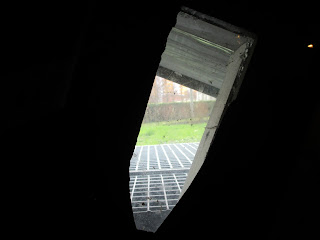Visiting the Jewish Museum Berlin
Two millennia of German-Jewish history


There is no way to describe this museum except with an aerial photograph. You actually enter through the old yellow building with the red roof. However, the museum itself is a wandering maze as you can see. It covers Jewish history from about 2000 years. Huge amount of exhibits and huge amount of walking.

All of the dark lines on the modern silver building are windows. And the only kind of windows that are in the building.
I just realized that I did not take any exterior pictures, so I am glad there are a lot online.
Lots of empty space and corridors. The windows on the right exhibit journals and pictures that have been donated by family members who survived the Holocaust.
Holocaust tower...this is looking upwards towards the sky. It is massive.


History and Futuristic Design
The Nazi regime closed the original Jewish Museum on Oranienburger Straße in 1938, just five years after its opening in 1933. It remained vacant until 1975 when Jewish groups decided to do something. It was in 1988 that the design by architect Daniel Libeskind trumped the rest, winning the contest announced by the Berlin government to create a new design for the museum.
Located in what used to be West Berlin, before the fall of the Wall, the museum today comprises a Baroque building, called the “Kollegienhaus” as well as Libeskind's creation, the new Deconstructivist-style building. Libeskind's building is accessible only through an underground passage that begins in the old Baroque building.
Libeskind's design was based on the premise that the Holocaust can never be erased from Germany's collective conscience, nor can the contribution of the Jews to Berlin's reconstruction be undermined.
Located in what used to be West Berlin, before the fall of the Wall, the museum today comprises a Baroque building, called the “Kollegienhaus” as well as Libeskind's creation, the new Deconstructivist-style building. Libeskind's building is accessible only through an underground passage that begins in the old Baroque building.
Libeskind's design was based on the premise that the Holocaust can never be erased from Germany's collective conscience, nor can the contribution of the Jews to Berlin's reconstruction be undermined.
Stairs
Halls that are dead ends.
The Garden of Exile and Emigration, in front of the south facade of the museum. Forty-nine concrete columns stand at an incline, with trees planted inside. Forty-eight columns, filled with Berlin earth, stand for 1948, the year the nation of Israel was born. The 49th column, filled with earth from Jerusalem, stands for Berlin.
Photo credit: Florida Center for Instructional Technology










































No comments:
Post a Comment